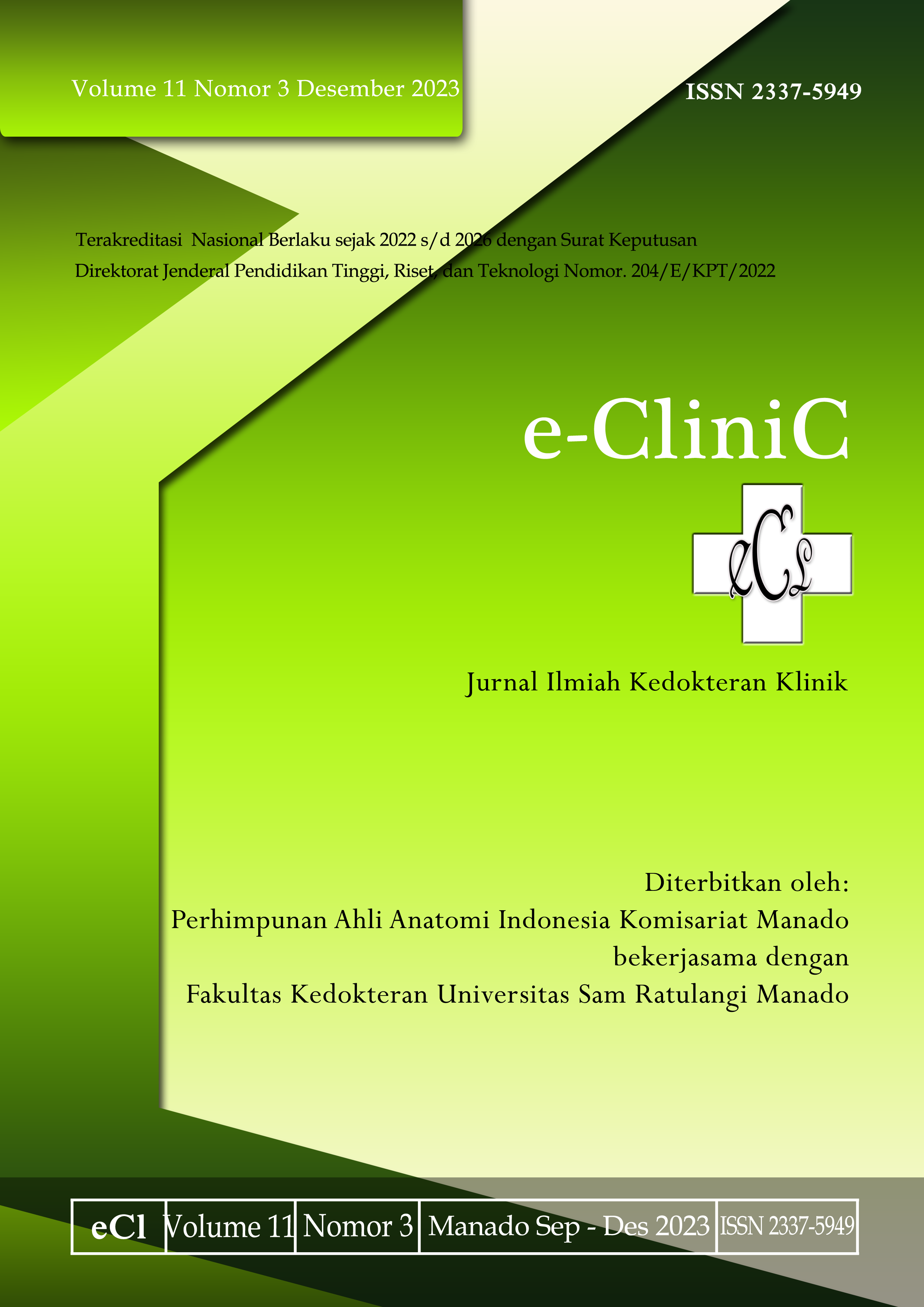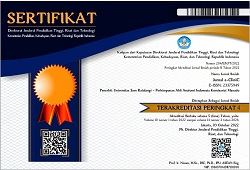Rehabilitasi Medik pada Nyeri Bahu Hemiplegia Pasca Stroke
DOI:
https://doi.org/10.35790/ecl.v11i3.45280Abstract
Abstract: According to WHO 2019, stroke is the second leading cause of death worldwide and a significant cause of long-term disability. One of the complications that often occurs after a stroke is hemiplegic shoulder pain that affects the patient with decreased functional use of the arm, decreased quality of life, higher rates of depression, prolonged hospitalization, and impaired rehabilitation. This study aimed to discuss about rehabilitation efforts in post stroke patients with hemiplegic shoulder pain. This was a literature review study by searching three databases (Google Scholar, Pubmed, and Clinical Key) to determine medical rehabilitation for hemiplegic shoulder pain. The results obtained 13 literatures that matched the criteria. Hemiplegic shoulder pain in many ways, such as reducing the functional use of the arm, reducing quality of life, increasing levels of depression, prolonged hospitalization, is to the point of interfering with the recovery process, namely rehabilitation. In conclusion, medical rehabilitation for hemiplegic shoulder pain has shown quite successful efforts in treating or restoring the condition of patient with hemiplegic shoulder pain. It is possible to carry out more extensive research regarding the underlying causes, examinations to diagnose hemiplegic shoulder pain, and more effective rehabilitation in the future.
Keywords: medical rehabilitation; hemiplegic shoulder pain; post stroke; quality of life
Abstrak: Menurut WHO 2019, stroke merupakan penyebab kematian kedua di dunia dan salah satu penyebab yang bermakna bagi disabilitas jangka panjang. Salah satu komplikasi yang sering terjadi setelah kejadian stroke ialah nyeri bahu hemiplegia yang memengaruhi penderita dengan penurunan penggunaan fungsional lengan, penurunan kualitas hidup, tingkat depresi yang lebih tinggi, rawat inap yang berkepanjangan, gangguan rehabilitasi. Penelitian ini bertujuan untuk mengetahui rehabilitasi medik pada nyeri bahu hemiplegia pada pasien pasca stroke menggunakan metode literature review dengan penelusuran pada tiga database (Google Scholar, Pubmed, dan Clinical Key). Hasil penelitian mendapatkan 13 literatur yang sesuai dengan kriteria. Nyeri bahu hemiplegia dalam banyak hal, seperti penurunan penggunaan fungsional lengan, penurunan kualitas hidup, tingkat depresi yang bertambah, rawat inap yang berkepanjangan, sampai mengganggu proses pemulihan membutuhkan rehabilitasi. Simpulan penelitian ini ialah penanganan rehabilitasi medik pada pasien pasca stroke dengan nyeri bahu hemiplegia telah menunjukkan upaya yang cukup berhasil dalam mengobati atau memulihkan kondisi tersebut Tidak menutup kemungkinan dilakukan penelitian yang lebih luas mengenai penyebab yang mendasari, pemeriksaan untuk mendiagnosis keadaan nyeri bahu hemiplegia maupun rehabilitasi yang lebih efektif di masa mendatang.
Kata kunci: penanganan rehabilitasi medik; nyeri bahu hemiplegia; pasca stroke; kuallitas hidup
References
Aprianda R. Stroke don’t be the one. Pusat Data dan Informasi Kementerian Kesehatan Republik Indonesia [Internet]. 2019 [cited 2022 Sept 8]. Available from: https://www.kemkes.go.id/article/ view/20030900004/stroke-don-t-be-the-one.html
Stroke. Centre For Disease Control and Prevention [Internet]. 2022 [cited 2022 Oct 9]. Available from: https://www.cdc.gov/stroke/facts.htm
Polie YJ, Sengkey LS, Marpaung E. Pengaruh kinesio taping terhadap nyeri dan kemampuan fungsional pada hemiplegic shoulder pain pascastroke [Internet]. Jurnal Medik dan Rehabilitasi. 2020;2(1):1-4. Available from: https://ejournal.unsrat.ac.id/index.php/jmr/article/view/28617
Kumar P. Hemiplegic shoulder pain in people with stroke: present and the future [Internet]. 2019 [cited 2022 Sept 11]. Pain Management. 2009;9(2):107-10. Available from: https://pubmed.ncbi. nlm.nih.gov/30681020/
Kalichman L, Ratmansky M. Underlying pathology and associated factors of hemiplegic shoulder pain. Am J Phys Med Rehabil. 2011;90(9):768-80.
About rehabilitation medicine. National Institute of Child Health and Human Development [Internet]. 2022 [cited 2022 Sept 27]. Available from: https://www.nichd.nih.gov/health/topics/rehabilitation-medicine/conditioninfo
Pan R, Zhou M, Cai H, Guo Y, Zhan L, Li M et al. A randomized controlled trial of a modified wheelchair arm-support to reduce shoulder pain in stroke patients. Clinical Rehabilitation. 2017;32(1):37-47. [Internet]. 2017 [cited 2022 Oct 2] Available from: https://pubmed.ncbi.nlm.nih.gov/28629270/
Kim TH, Chang MC. Comparison of the effectiveness of pulsed radiofrequency of the suprascapular nerve and intra-articular corticosteroid injection for hemiplegic shoulder pain management. Journal of Integrative Neuroscience. 2021;20(3):687–93.
Sui M, Jiang N, Yan L, Liu J, Luo B, Zhang C, et al. Effect of electroacupuncture on shoulder subluxation in poststroke patients with hemiplegic shoulder pain: A sham-controlled study using multidimensional musculoskeletal ultrasound assessment. Pain Research and Management. 2021;2021:1–9.
Yang L, Yang J, He C. The effect of kinesiology taping on the hemiplegic shoulder pain: A randomized controlled trial. Journal of Healthcare Engineering. 2018;2018:1–7.
Sencan S, Celenlioglu AE, Karadag-Saygı E, Midi İ, Gunduz OH. Effects of fluoroscopy-guided intraarticular injection, suprascapular nerve block, and combination therapy in hemiplegic shoulder pain: A prospective double-blind, randomized clinical study. Neurological Sciences. 2019;40(5):939–46.
Choi G, Chang MC. Effects of high-frequency repetitive transcranial magnetic stimulation on reducing hemiplegic shoulder pain in patients with chronic stoke: A randomized controlled trial. International Journal of Neuroscience. 2017;128(2):110–6
Zhou M, Li F, Lu W, Wu J, Pei S. Efficiency of neuromuscular electrical stimulation and transcutaneous nerve stimulation on hemiplegic shoulder pain: A randomized controlled trial. Archives of Physical Medicine and Rehabilitation. 2018;99(9):1730–9
Kim MG, Lee SA, Park EJ, Choi MK, Kim JM, Sohn MK, et al. Elastic dynamic sling on subluxation of hemiplegic shoulder in patients with subacute stroke: A multicenter randomized controlled trial. International Journal of Environmental Research and Public Health (IJERPH). 2022;19(16):9975.
Wilson RD, Bennett ME, Nguyen VQC, Bock WC, O’Dell MW, Watanabe TK, et al. Fully implantable peripheral nerve stimulation for hemiplegic shoulder pain: A multi-site case series with two-year follow-up. Neuromodulation: technology at the neural interface. 2017;21(3):290–5.
Mendigutía-Gómez A, Quintana-García MT, Martín-Sevilla M, de Lorenzo-Barrientos D, Rodríguez-Jiménez J, Fernández-de-las-Peñas C, et al. Post-needling soreness and trigger point dry needling for hemiplegic shoulder pain following stroke. Acupuncture in Medicine. 2020;38(3):150– 7.
Kim M-S, Kim SH, Noh S-E, Bang HJ, Lee K-M. Robotic-assisted shoulder rehabilitation therapy effectively improved poststroke hemiplegic shoulder pain: a randomized controlled trial. Archives of Physical Medicine and Rehabilitation. 2019;100(6):1015–22.
Korkmaz N, Gurcay E, Demir Y, Tezen Ö, Korkmaz İ, Atar MÖ, et al. The effectiveness of high-intensity laser therapy in the treatment of post-stroke patients with hemiplegic shoulder pain: A prospective randomized controlled study. Lasers in Medical Science. 2021;37(1):645–53.
Huang Y-C, Leong C-P, Tso H-H, Chen M-J, Liaw M-Y, Hsieh H-C, et al. The long-term effects of hyaluronic acid on hemiplegic shoulder pain and injury in stroke patients. Medicine. 2018;97(35).
Zhou ZY. Chinese Internal Medicine (22nd ed(. China: China Traditional Medicine Press; 2009
Kushartanti BMW. Terapi Latihan Pascacedera Bahu. MEDIKORA. 2009;5(2):212-26.
Downloads
Published
How to Cite
Issue
Section
License
Copyright (c) 2023 Joshua Manurung, Christopher Lampah, Joudy Gessal

This work is licensed under a Creative Commons Attribution-NonCommercial 4.0 International License.
COPYRIGHT
Authors who publish with this journal agree to the following terms:
Authors hold their copyright and grant this journal the privilege of first publication, with the work simultaneously licensed under a Creative Commons Attribution License that permits others to impart the work with an acknowledgment of the work's origin and initial publication by this journal.
Authors can enter into separate or additional contractual arrangements for the non-exclusive distribution of the journal's published version of the work (for example, post it to an institutional repository or publish it in a book), with an acknowledgment of its underlying publication in this journal.
Authors are permitted and encouraged to post their work online (for example, in institutional repositories or on their website) as it can lead to productive exchanges, as well as earlier and greater citation of the published work (See The Effect of Open Access).







